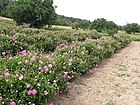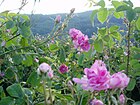Note: This is a project under development. The articles on this wiki are just being initiated and broadly incomplete. You can Help creating new pages.
Difference between revisions of "Rosa damascena"
(Created page with "{{stub}} ==Uses== {{Uses|}}, {{Uses|}}, {{Uses|}}, {{Uses|}}, {{Uses|}}, {{Uses|}}, {{Uses|}}, {{Uses|}}, {{Uses|}}, {{Uses|}}, {{Uses|}}.<ref name="Uses"/> ==Parts Used== {{...") |
|||
| (One intermediate revision by the same user not shown) | |||
| Line 1: | Line 1: | ||
| − | + | [[File:MHNT - Rosier de Damas.jpg|thumb|right]] | |
| + | '''Rosa x damascena''' is a deciduous shrub that can grow up to 1.50 metres tall. It is harvested from the wild for local use as a food, medicine and source of materials. | ||
==Uses== | ==Uses== | ||
| − | {{Uses|}}, {{Uses| | + | {{Uses|Cold}}, {{Uses|Cancer}}.<ref name="Uses"/> |
==Parts Used== | ==Parts Used== | ||
| − | {{Parts Used|}}, {{Parts Used| | + | {{Parts Used|Young leaves}}, {{Parts Used|Petals}}, {{Parts Used|Fruits}}, {{Parts Used|Leaves}}. |
==Chemical Composition== | ==Chemical Composition== | ||
| − | <ref name="chemical composition"/> | + | It contains β-citronellol (48.2 %), geraniol (17.0 %), β-phenylethyl benzoate (5.4 %) and phenyl ethyl alcohol (5.1 %) as the main components. The MIC values of oil were in the ranges of 0.125–1 μl/ml.<ref name="chemical composition"/> |
==Common names== | ==Common names== | ||
| − | {{Common names|sa=|en=|gu=|hi=|kn=|ks=|ml=|mr=|pa=|ta=|te=}} | + | {{Common names|sa=Atimanjula|en=Damask Rose|gu=|hi=Gulab|kn=Gulabihuvu|ks=|ml=Panniruppu|mr=Gulab|pa=|ta=Pannirpu|te=Pannir roja}}.<ref name="Common names"/> |
==Properties== | ==Properties== | ||
| Line 16: | Line 17: | ||
===Dravya=== | ===Dravya=== | ||
===Rasa=== | ===Rasa=== | ||
| − | |||
===Guna=== | ===Guna=== | ||
| Line 29: | Line 29: | ||
==Habit== | ==Habit== | ||
| − | {{Habit|}} | + | {{Habit|Deciduous shrub}} |
==Identification== | ==Identification== | ||
| Line 48: | Line 48: | ||
==Mode of Propagation== | ==Mode of Propagation== | ||
| − | {{Propagation|}} | + | {{Propagation|Seeds}}, {{Propagation|Cuttings of half-ripe wood}}, {{Propagation|Cuttings of mature wood }}, {{Propagation|Division of suckers}}, {{Propagation|Air layering}} |
==How to plant/cultivate== | ==How to plant/cultivate== | ||
| − | <ref name="How to plant/cultivate"/> | + | Succeeds in most soils, preferring a circumneutral soil and a sunny position. Grows well in heavy clay soils. Dislikes water-logged soils. The plant resists frost.<ref name="How to plant/cultivate"/> |
==Commonly seen growing in areas== | ==Commonly seen growing in areas== | ||
| Line 58: | Line 58: | ||
==Photo Gallery== | ==Photo Gallery== | ||
<gallery class="left" caption="" widths="140px" heights="140px"> | <gallery class="left" caption="" widths="140px" heights="140px"> | ||
| − | + | Bulgarian Rosa damascena.JPG | |
| + | Darıcılar-gül-IMG-20170603-WA0002.jpg | ||
| + | Golab being make in Meymand - Fars 09.jpg | ||
| + | Gole mohamadi.JPG | ||
| + | Masovo otglejdane na rozi v zlatosel.jpg | ||
| + | MHNT - Rosier de Damas.jpg | ||
</gallery> | </gallery> | ||
| Line 64: | Line 69: | ||
<references> | <references> | ||
| − | <ref name="chemical composition">[ | + | <ref name="chemical composition">[https://www.tandfonline.com/doi/abs/10.1080/22311866.2011.10719069 Chemical constituents]</ref> |
| − | <ref name="Leaf">[" | + | <ref name="Leaf">[Morphology]</ref> |
| + | <ref name="Common names">[http://www.flowersofindia.net/catalog/slides/Damask%20Rose.html Common names]</ref> | ||
| − | <ref name="How to plant/cultivate">[ | + | <ref name="How to plant/cultivate">[http://temperate.theferns.info/plant/Rosa+x+damascena Cultivation]</ref> |
<ref name="Uses">Indian Medicinal Plants by C.P.Khare</ref> | <ref name="Uses">Indian Medicinal Plants by C.P.Khare</ref> | ||
</references> | </references> | ||
==External Links== | ==External Links== | ||
| − | * [ ] | + | * [https://www.sciencedirect.com/science/article/pii/S2225411015000954 Rosa damascena on sciencedirect.com] |
| − | * [ ] | + | * [https://www.mdedge.com/dermatology/article/36592/aesthetic-dermatology/rosa-damascena Rosa damascena on mdedge.com] |
| − | * [ ] | + | * [https://www.rosefestivalkazanlak.com/rosa-damascena-importance-bulgarian-rose-valley/ Rosa damascena on rosefestivalkazanlak.com] |
[[Category:Herbs]] | [[Category:Herbs]] | ||
Latest revision as of 12:34, 31 July 2020
Rosa x damascena is a deciduous shrub that can grow up to 1.50 metres tall. It is harvested from the wild for local use as a food, medicine and source of materials.
Contents
- 1 Uses
- 2 Parts Used
- 3 Chemical Composition
- 4 Common names
- 5 Properties
- 6 Habit
- 7 Identification
- 8 List of Ayurvedic medicine in which the herb is used
- 9 Where to get the saplings
- 10 Mode of Propagation
- 11 How to plant/cultivate
- 12 Commonly seen growing in areas
- 13 Photo Gallery
- 14 References
- 15 External Links
Uses
Parts Used
Young leaves, Petals, Fruits, Leaves.
Chemical Composition
It contains β-citronellol (48.2 %), geraniol (17.0 %), β-phenylethyl benzoate (5.4 %) and phenyl ethyl alcohol (5.1 %) as the main components. The MIC values of oil were in the ranges of 0.125–1 μl/ml.[2]
Common names
| Language | Common name |
|---|---|
| Kannada | Gulabihuvu |
| Hindi | Gulab |
| Malayalam | Panniruppu |
| Tamil | Pannirpu |
| Telugu | Pannir roja |
| Marathi | Gulab |
| Gujarathi | |
| Punjabi | |
| Kashmiri | |
| Sanskrit | Atimanjula |
| English | Damask Rose |
.[3]
Properties
Reference: Dravya - Substance, Rasa - Taste, Guna - Qualities, Veerya - Potency, Vipaka - Post-digesion effect, Karma - Pharmacological activity, Prabhava - Therepeutics.
Dravya
Rasa
Guna
Veerya
Vipaka
Karma
Prabhava
Habit
Identification
Leaf
| Kind | Shape | Feature |
|---|---|---|
Flower
| Type | Size | Color and composition | Stamen | More information |
|---|---|---|---|---|
| {{{5}}} |
Fruit
| Type | Size | Mass | Appearance | Seeds | More information |
|---|---|---|---|---|---|
Other features
List of Ayurvedic medicine in which the herb is used
Where to get the saplings
Mode of Propagation
Seeds, Cuttings of half-ripe wood, Cuttings of mature wood , Division of suckers, Air layering
How to plant/cultivate
Succeeds in most soils, preferring a circumneutral soil and a sunny position. Grows well in heavy clay soils. Dislikes water-logged soils. The plant resists frost.[5]
Commonly seen growing in areas
[[:Category:Herbs that are commonly seen in the region of |]], [[:Category:Herbs that are commonly seen in the region of |]], [[:Category:Herbs that are commonly seen in the region of |]], [[:Category:Herbs that are commonly seen in the region of |]], [[:Category:Herbs that are commonly seen in the region of |]].
Photo Gallery
References
- ↑ Indian Medicinal Plants by C.P.Khare
- ↑ Chemical constituents
- ↑ Common names
- ↑ [Morphology]
- ↑ Cultivation
External Links
- Ayurvedic Herbs known to be helpful to treat Cold
- Ayurvedic Herbs known to be helpful to treat Cancer
- Herbs with Young leaves used in medicine
- Herbs with Petals used in medicine
- Herbs with Fruits used in medicine
- Herbs with Leaves used in medicine
- Herbs with common name in Kannada
- Herbs with common name in Hindi
- Herbs with common name in Malayalam
- Herbs with common name in Tamil
- Herbs with common name in Telugu
- Herbs with common name in Marathi
- Herbs with common name in Sanskrit
- Herbs with common name in English
- Habit - Deciduous shrub
- Index of Plants which can be propagated by Seeds
- Index of Plants which can be propagated by Cuttings of half-ripe wood
- Index of Plants which can be propagated by Cuttings of mature wood
- Index of Plants which can be propagated by Division of suckers
- Index of Plants which can be propagated by Air layering
- Herbs that are commonly seen in the region of
- Herbs






